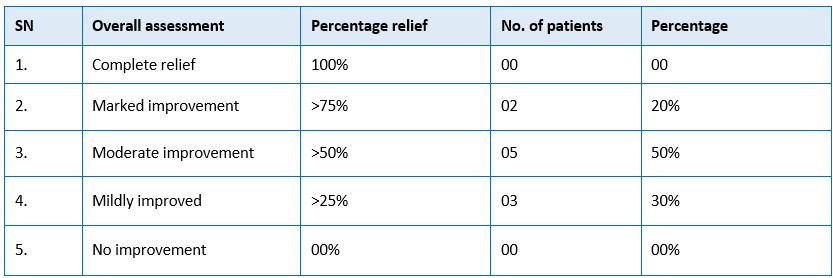Evaluation of the effect of Bala Tailam Nasya and Baladi Kwatha Pana in the management of Avabahuka - A Pilot Study
DOI:
https://doi.org/10.21760/jaims.9.3.3Keywords:
Nasya, Baladi Taila, Baladi Kwath, Avabahuka, Frozen ShoulderAbstract
Avabahuka is a disease mainly affects the Amsa Sandhi (shoulder joint) which is painful, affecting the normal routine life style of an individual. The sedentary and restless lifestyles of people, and lack of priority to physical exercise, have an effect on the body that can cause disease. The main Dosha involved Avabahuka is Vatadosha and the treatment adopted for this are like Snayu-Sandhi-Asthi-Gata-Vata treatment. In Frozen Shoulder synovial inflammation occurs followed by capsular fibrosis. The shoulder joint becomes gradually painful and stiff with a reduction in range of motion. The current pilot study aim is to investigate the impact of Nasya with Baladi Taila and Baladi Kwath in Avabahuka. There are references for Nasya Karma in Avabahuka. Acharya Sushruta and others have considered it as Vataja Vikara. Amsa Shosha can be considered a pre-disease stage in which loss or dryness of the Shleshaka Kapha is found, as well as other symptoms like Shula during movement of shoulder joint.
Downloads
References
Charaka Samhita. Ayurveda Deepika commentary by Chakrapani datta. In: Yadav T, editor. Indriya sthana, 11/8-9. Fourth Edition. Varanasi: Chaukhamba Orientalia; 1994. pp. 8–9.
Shastri Pandit Kashinath, Chaturvedi Gorakhanatha Charaka Samhita of Agnivesh, edited with vidyotini hindi commentary, Chaukhambha Bharati Academy; part-1; Sutra Sthana 1992; 20/11:399.
Tripathi Bramhanand. Charaka Samhita of Agnivesh, edited with Charaka Chandrika hindi commentary, Chaukhambha Surbharati Prakashan; part-2; Chikitsa Sthana. 1998;28/98:956
Shastri Pandit Kashinatha and Chaturvedi Gorakhanatha, Charaka Samhita of Agnivesh, edited with vidyotini hindi commentary, Chaukhambha Bharati Academy; part-1; 1992; Sutra Sthana 20/11:399.
Sushrut: Sushruta Samhita, edited with Ayurvedatatvasandeepika Hindi commentary by Shastri Kaviraj Ambika Dutta. Varanasi India: Chaukhambha Sanskrit Sansthan; part-1; 2014; NidanSthana 1/82:304
Kanjiv Lochan, Vagbhata: Astanga Hridaya English commentary; Chaukhambha Publications; vol-2; 2017; Nidhanasthana 15/43:140
Manske RC, Prohaska D. Diagnosis and management of adhesive capsulitis. Curr Rev Musculoskelet Med. 2008. 1007 PMID: 19468904 DOI: /s12178-008-9031-6;1:180–189.
Chokkalingam M, Saradha S, Navitha A. Incidence and clinical profile of patients with a frozen shoulder after cardiac surgery y. J Clin Prevent Cardiol 2017; 6(4):142.
Prevalence and determinants of frozen shoulder in patients with diabetes: a single center experience from Pakistan. Cureus. 2017. 9(8):1544.
Nirmal, et al. Management of Avabahuka (Frozen Shoulder) with Abhyanga Swedana, Pratimarsha Nasya and Ayurveda Medicines: A Case Study, World Journal of Pharmaceutical Research. 2017;6(8):2099-2103. ISSN 2277–7105.
Anna Moreshwar Kunte and Krishna Ramachandra Shastri Navre, Asthanga Hridaya, Varanasi; Chaukhambha Surabharati Prakashan; 2004; p. 287
Kaviraj Atridev Gupt, Vagbhata: Astanga Hridaya vidyotini Hindi commentary; Chaukhambha Publications; vol-1; 2017; Chikitsasthana 21/73-81:pg. 422
Indra Dev Tripathi; Chakradatta; chakradatta Samhita; Savimarsha Vaidyaprabha Hindi commentary; edited by Acharya Ramnath Dwivedi; Chaukhambha Publications; vol-1; Chikitsaprakarana verse26:pg. 135
Carolyn K. (2013) Therapeutic Exercise –foundations and techniques, New Delhi: Jaypee Brothers Medical Publishers.
Patil P. (2014, May 2) Effect of Masha-Saindhava Taila in Avabahuka (IJAM).
Ashtanga Sangraha, Sasilekha commentary, Sutra sthana, 29th chapter, Govt of Kerala, (Govt. Ayurveda college, Thiruvananthapuram) 1982:399.
Ashtanga Sangraha, Sasilekha commentary, Sutra sthana, 29th chapter, Govt of Kerala, (Govt. Ayurveda college, Thiruvananthapuram) 1982:403.
Charkapani tika on Charaka Samhita, Chaukhambha Bharati Academy, Varanasi, Reprint 2005: 102.















